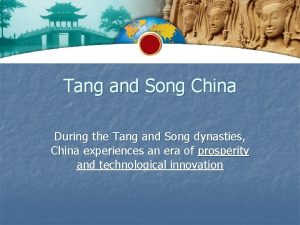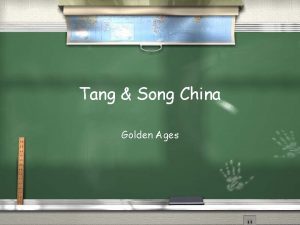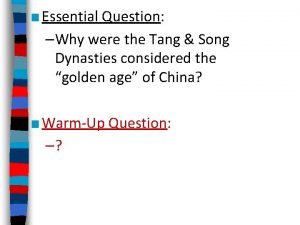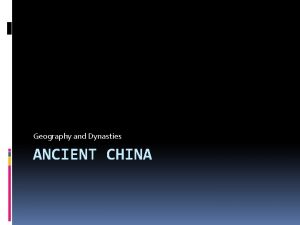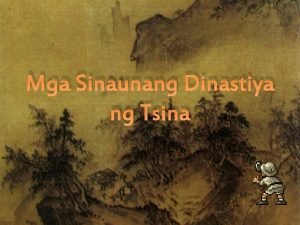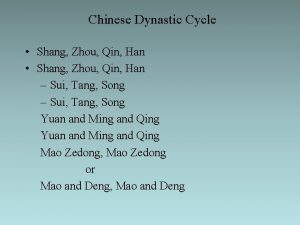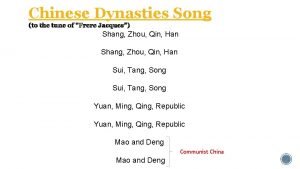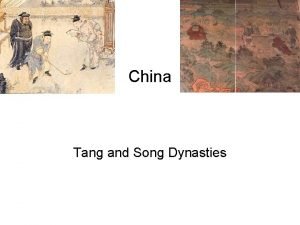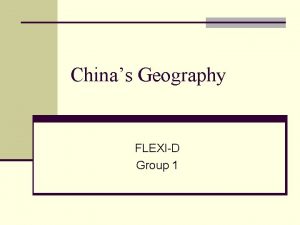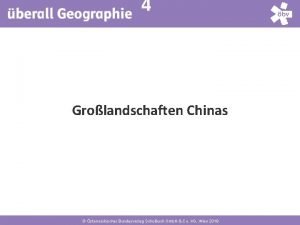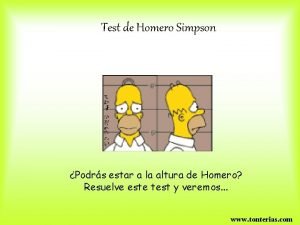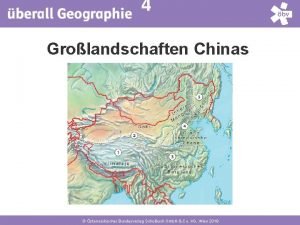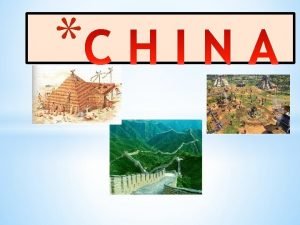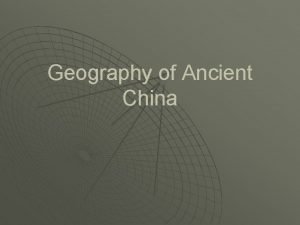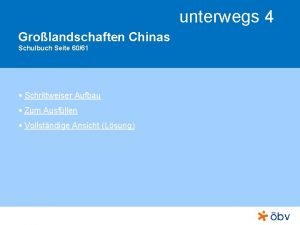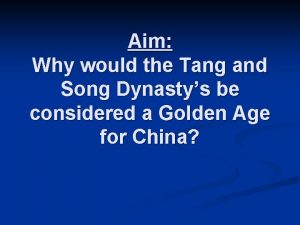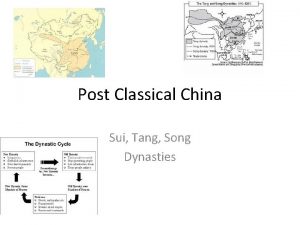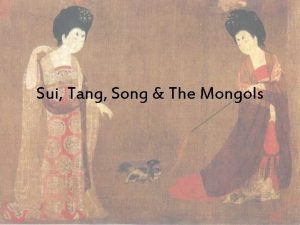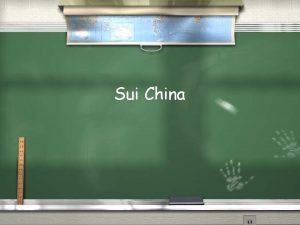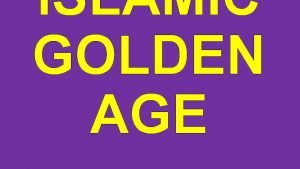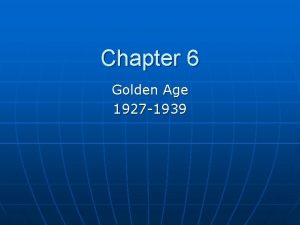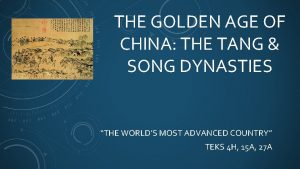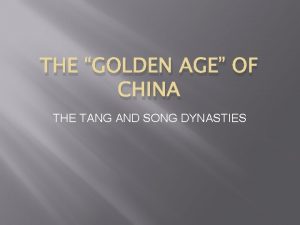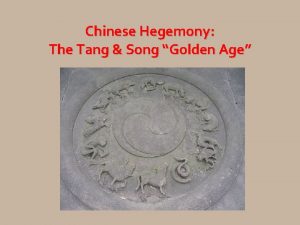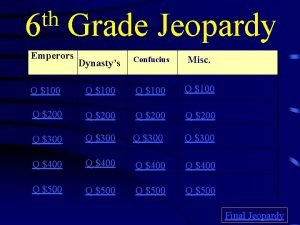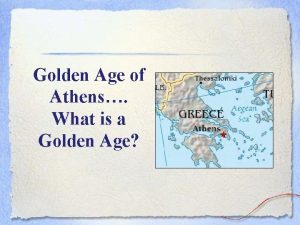Chinas Golden Age Dynastys The Sui the Tang



























- Slides: 27

China’s Golden Age Dynasty’s The Sui, the T’ang and the Song (Sung)

What is a Golden Age? • A time or period, in a specific culture or civilization: - of “peace, harmony, stability, and prosperity (wikipedia)” - “of great happiness, prosperity, and achievement (merriam-webster online dictionary)” - “where enlightenment, achievement, and/or advancement is at its height (me : )”

• What other civilization’s experienced a Golden Age? And what achievements or advancements are proof of this? • What is the opposite of a Golden Age?

When was China’s. GOLDEN AGE? Sui dynasty (A. D. 581 -617) Han dynasty (206 B. C. -A. D. 220) T’ang dynasty (A. D. 618 -907) Song (Sung) dynasty (960 -1279)

Inventions • ACTIVITY • On the handout are descriptions of things invented in China during the Han, Sui, Tang and Song Dynasty’s. • Read each one and try to figure out which invention or advancement is being described.

5 Han rulers strengthened the economy and government of China. ECONOMY GOVERNMENT They improved canals and roads. They made Confucianism the official belief of the state. They set up granaries across the empire. They relied on well-educated scholars to run the government. They reorganized finances. They imposed a government monopoly on iron and salt. They opened up the Silk Road, a trade route linking China and the West. They used a civil service exam to find the most qualified officials.

5 The Han Golden Age Han China made such tremendous advances in so many fields, that the Chinese later called themselves “the people of Han. ” SCIENCE Wrote texts on chemistry, zoology, and botany. Measured movements of stars and planets. Invented seismograph to measure earthquakes. TECHNOLOGY Made paper out of wood pulp. Pioneered advanced methods of shipbuilding. Invented the rudder, fishing reels, wheelbarrows, and suspension bridges. MEDICINE Diagnosed diseases. Used herbal remedies and other drugs for treatments. Developed anesthetics. Explored uses of acupuncture. THE ARTS Built grand temples and palaces. Produced jade and ivory carvings and ceramic figures. Improved bronzeworking and silkmaking techniques.

Fall of the Han • Perfect example of a “fall” within a dynastic cycle • Ushered in the Era of the Three Kingdoms - Civil War (220 -589)

Time of the Three Kingdoms The Three Kingdoms era began in 220 AD. After the Han dynasty fell, three powerful states began a war for power and control over China. The three states were the Wu state, Wei state, and Shu-Han state. The three main leaders during this war was Cao Pi of the Wei State, Liu Bei of the Shu-han state, and Sun Quan, the son of Sun Jian of the Wu state. These three people were the kings of their states.

Three Kingdoms China’s Dark Ages? Sort of! - Sinicization of non-Han Chinese groups - Growing popularity of Buddhism - Inventions (like gunpowder) - Advances in medicine (surgery) and other areas

The Sui (A. D. 581 -617) • Ruthless and tyrannical (comparable to that of Qin) • High tax burden and mandatory labor and conscription for: • Maintenance and extensions of the Great Wall • Building of the Grand Canal • Unsuccessful wars to conquer the rest of the Korean peninsula and Vietnam • As a result: Sui emperor assassinated and a leading noble took power and began the Tang dynasty • But……….

Grand Canal (completed in 610)


The T’ang (A. D. 618 -907) Considered by historians as the climax or height of China’s Golden Age and even Chinese civilization! Empress Wu Diamond Sutra

Landscape Painting

The capital at Chang’an (Xian)



Buddhism becomes a permanent entity of Chinese culture (sinicized) Leshan Buddha

Major achievements in Literature and Art -Diamond Sutra - Li Bo and Du Fu (Literature - Poetry) (made possible by which invention? That also made “paper money” possible!)

Activity • Read excerpts from Li Bo and Du Fu. • Compare/contrast the writings of Li Bo and Du Fu. • What can their writings tell us about life in China during the Tang? • What can a country’s Art tell a historian?

Collapse of the T’ang • Ah the perils of love! Consort Yang Emperor Xuanzong

The Song (960 -1279)

Song • Civilian rule (by scholars appointed by the Emperor and his scholar advisors) replaced military governors (even in the provinces) • New classes developed: -Gentry (landowning scholars) -Merchant class (educated business owners) • As a result – Economy grew – Land government were no longer the only means of attaining wealth and prestige – Confucianism returned (known as Neo-Confucianism)!!! Why? (- there was a synthesis of Confucianism, Taoism, and Buddhism as a result in Civil Svc exam and culture too) • Conclusion: The Song dynasty “fine-tuned” the developments of the former dynasties! • But……….

Chinese Traditional Social Hierarchy

Fall of the Song • What would be the price for such concentration on internal and domestic developments? And on education and scholarship? • The barbarians in the north pushed the Song dynasty south to the Yangtze River • The Mongols also were unifying under the leadership of the man pictured below and were tempted by the wealth of the Song

NEXT: The Rise of the Mongols “Wrath of God”
 Chinas dynastys
Chinas dynastys Song dynasty rulers
Song dynasty rulers The tang and song eras were a golden age of
The tang and song eras were a golden age of Golden age of tang and song dynasties
Golden age of tang and song dynasties The tang and song eras were a golden age of
The tang and song eras were a golden age of Chinese dynasties
Chinese dynasties Sui tang and song dynasties
Sui tang and song dynasties Isa sa mga punong ministro ni shih
Isa sa mga punong ministro ni shih Fsebo
Fsebo Chinese dynastic cycle
Chinese dynastic cycle Sui tang and song dynasties
Sui tang and song dynasties Sui tang and song dynasties
Sui tang and song dynasties Cê sủi
Cê sủi Sui tang song
Sui tang song How did the sui and tang dynasties reunite china
How did the sui and tang dynasties reunite china Shang zhou qin han sui tang song
Shang zhou qin han sui tang song Stone age chronology
Stone age chronology Iron age bronze age stone age timeline
Iron age bronze age stone age timeline Venn diagram of tang and song dynasties
Venn diagram of tang and song dynasties Chinas physical features
Chinas physical features Greece's national animal
Greece's national animal Whats chinas longest river
Whats chinas longest river China großlandschaften
China großlandschaften Tomografia homero simpson
Tomografia homero simpson überall geographie 4
überall geographie 4 Regiones chinas
Regiones chinas Taklamakan desert map
Taklamakan desert map Großlandschaften china karte
Großlandschaften china karte

